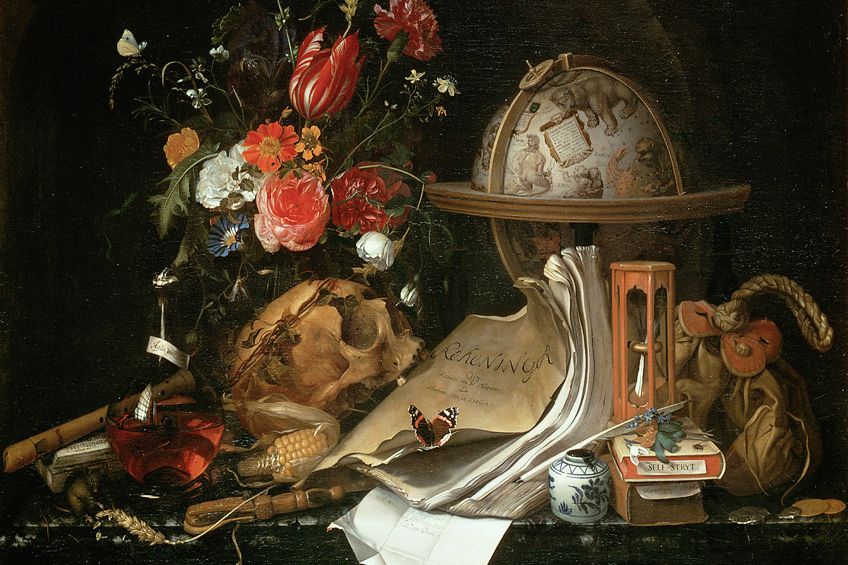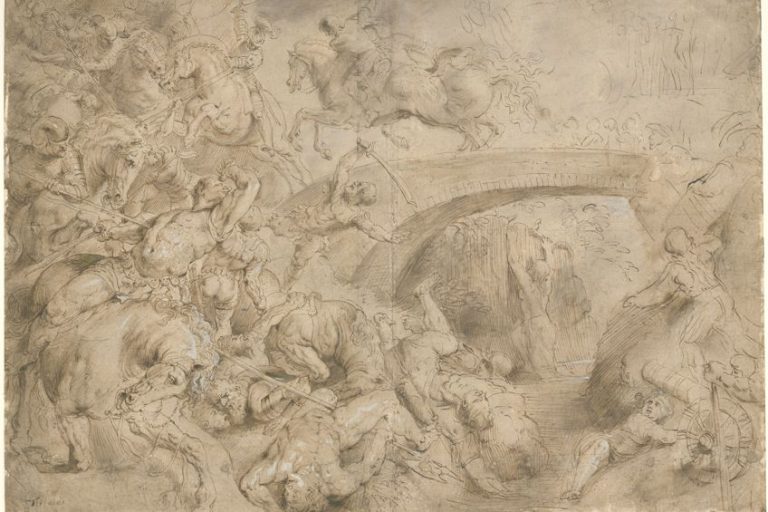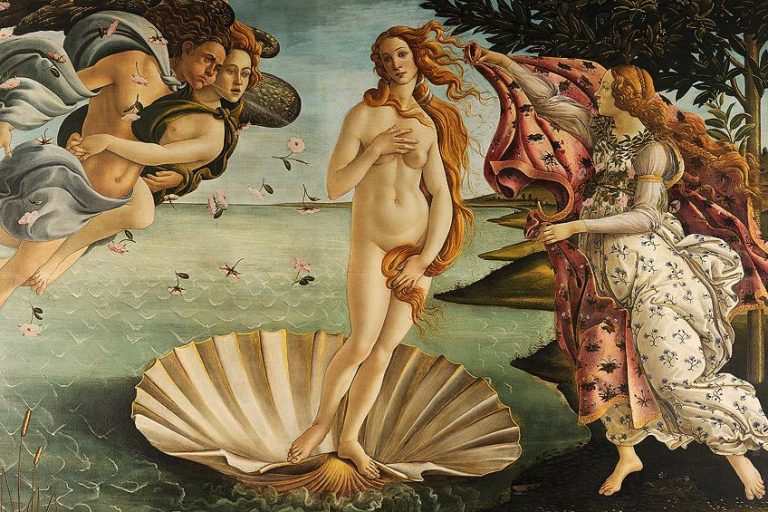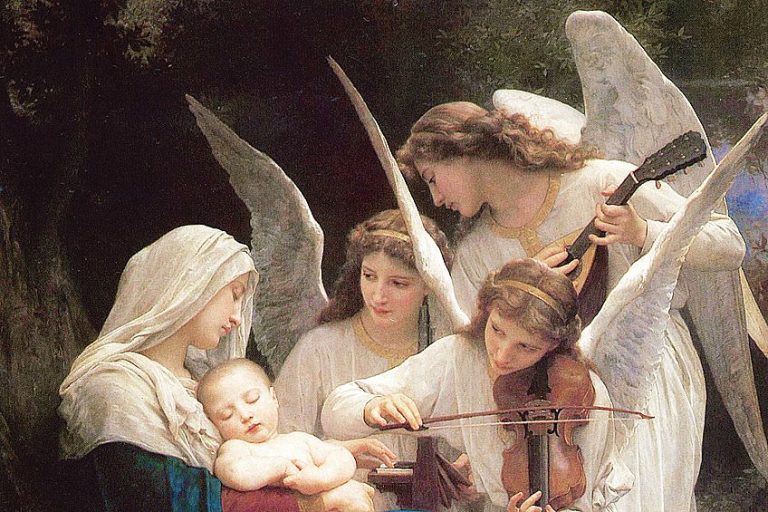Memento Mori Art – Symbolic Meditations on Death
Memento mori is a philosophical reminder of the inevitable nature of death. In Latin, it translates to “remember that you will die”. The term arose from the minds of the great thinkers of classical antiquity, and memento mori symbols have been found in architecture and funeral art as far back as the medieval period. Memento mori art ranges from skull paintings to rotten fruit paintings, as well as other macabre symbols of death in art.
Memento Mori Philosophy and History
The philosophers of classic antiquity had a deep desire to understand the intricacies of human life, as well as the inevitable end chapter that we all must eventually experience: death. In his book Phaedo, Plato said that philosophy is about “nothing but being dead and dying”. Democritus, another philosopher, went into solitude by visiting tombs as training. The Stoic school and its followers also practiced this discipline, for whom it was a necessary meditation to contemplate death. They were reminded to always keep the temporary nature of existence in their minds so they may appreciate life more.
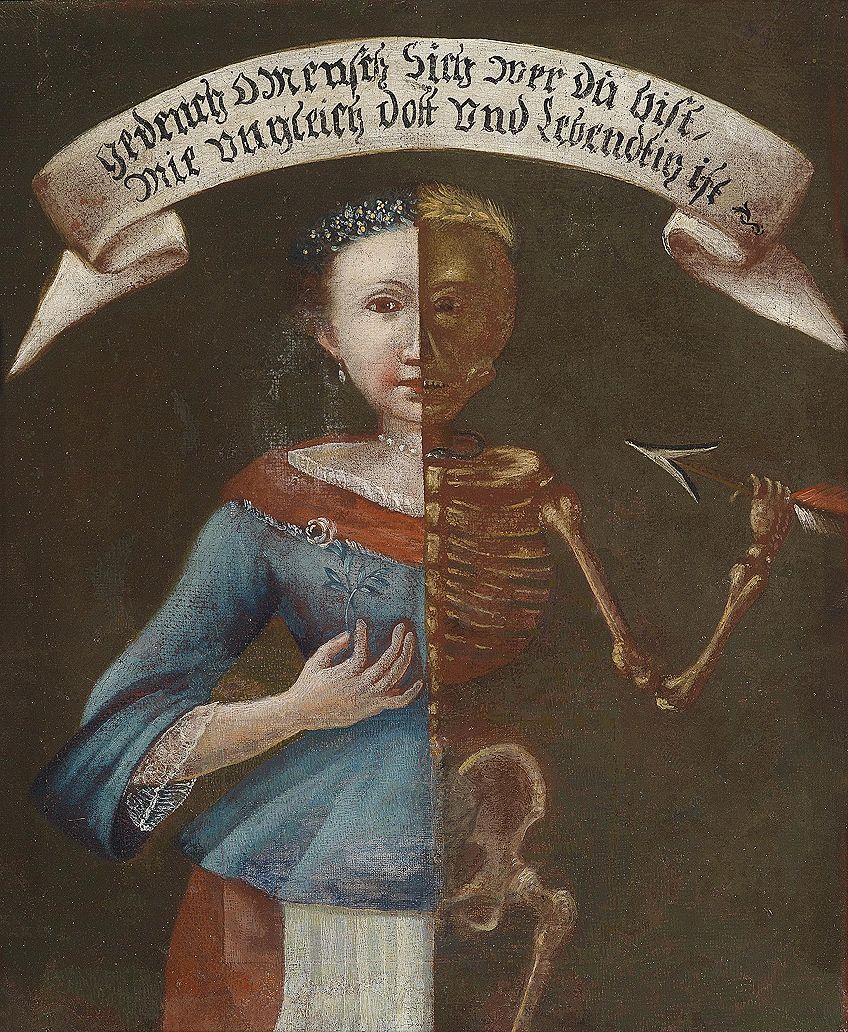
Memento Mori Art in Medieval and Victorian Europe
The reaction of those in classic antiquity to the concept of memento mori was to live life to the fullest, as death was around the corner. The era of Christianity however, ushered in the repurposing of what memento mori represented. For Christians, death was something that was seen as a salvation from the burdens of earthly pleasures and a step towards the heavenly afterlife.
For the people of classic antiquity, death was a reason to celebrate life, whereas for Christians, it was a reminder not to sin in fear of being rejected at the Pearly Gates.
The most evident places to look for memento mori symbols are in architecture and funeral art. Cadaver tombs were a 15th-century practice among the wealthy, where the tomb of the deceased would have the effigy of a decaying corpse displayed on it. Later Protestant tombstones in the United States would often depict skeletons and skulls. The Capuchin Crypt in Rome or the Chapel of Bones in Portugal are two examples of “memento mori architecture” that can be found in Europe, the walls of which are covered with human bones and skulls.
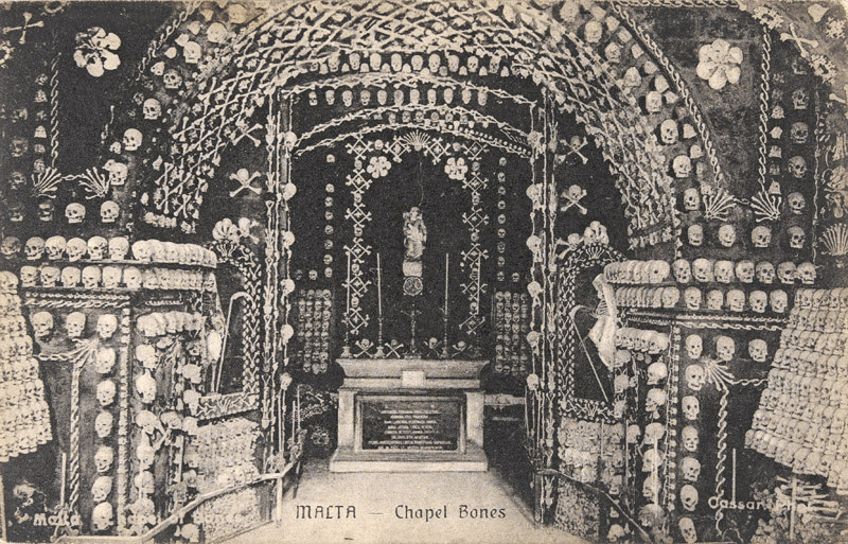
Clocks and other timepieces are also common objects from this period that would contain memento mori symbols, as they represent the passing of time in its never-ending and persistent countdown to death. In some of the public clocks in Augsburg in Germany, it is death who rings the hour hand. In the early 17th century, memento mori artists would create jewelry such as pendants, mourning rings, and lockets that portrayed motifs of coffins, skulls, and bones. In Holland, an artistic movement known as Vanitas was popular for its famous paintings of death, which were painted with various symbolic objects combined into a skull still life.
As early examples of memento mori paintings, these works were created with combinations of skulls, dying flowers, butterflies, and hourglasses, together representing the impermanence of human life and the marching on of time.
Memento Mori Art in the Americas
The Puritan Protestant community in the 17th century had a large influence on Colonial American art, leading to a rise in the use of memento mori paintings. Puritans believed that art drew man away from God and toward the Devil. Portraits, however, were considered historical documents that recorded their lineage and were therefore allowed.
Not many famous paintings of death exist from this period, but portraits that were done by Puritan artists such as Thomas Smith often contained memento mori symbols, portraying his inevitable death as a soldier by painting a skull under his hand in his self-portrait.
Skull painting is also a common theme in the Mexican festival, the Day of the Dead, where Mexicans create skull-shaped candles and bread made to look like bones in order to celebrate the life of those that have passed. José Guadalupe Posada was a Mexican engraver that was famous for his depictions of famous people as skeletons. Another form of memento mori can be found in the Calavera, which is a kind of poem recited to the living as if they had already died.
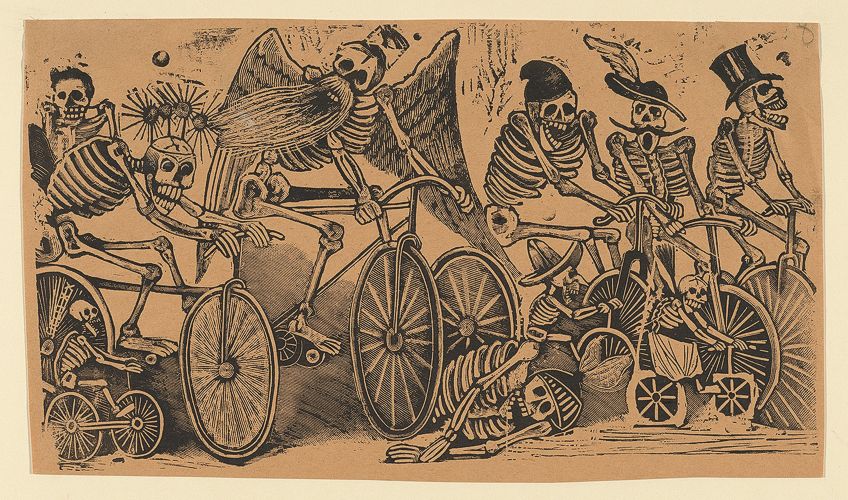
Memento Mori Art and Artists
Memento mori is more of a philosophy than a movement bound to a certain period, meaning that examples of memento mori symbolism can be found in the works of artists of many genres, as death is a common experience shared by all people throughout time. Let us look at some of these famous paintings of death.
The Dance of Death (1493) by Michael Wolgemut
Michael Wolgemut was a printmaker and painter born in 1434 in Nuremberg, Germany. He is not only remembered for his artwork but also for the huge contribution that his workshops had in producing and developing artistic talent such as Albrecht Dürer.
Wolgemut was a prominent figure among artists that were then reviving the old tradition of German woodcuts. Wolgemut would design the woodcuts which would then be used to print illustrations for book publishers in Nuremberg, and the best of these were sold as artworks separately. In a personal capacity, he was known for his various commissioned artwork done for places such as the Church of St. Mary in Zwickau, the Church of the Augustinian Friars at Nuremberg, and the town hall of Goslar.
The Dance of Death is a sub-genre of memento mori art. It became popular during the Renaissance but had its origins in the late medieval period.
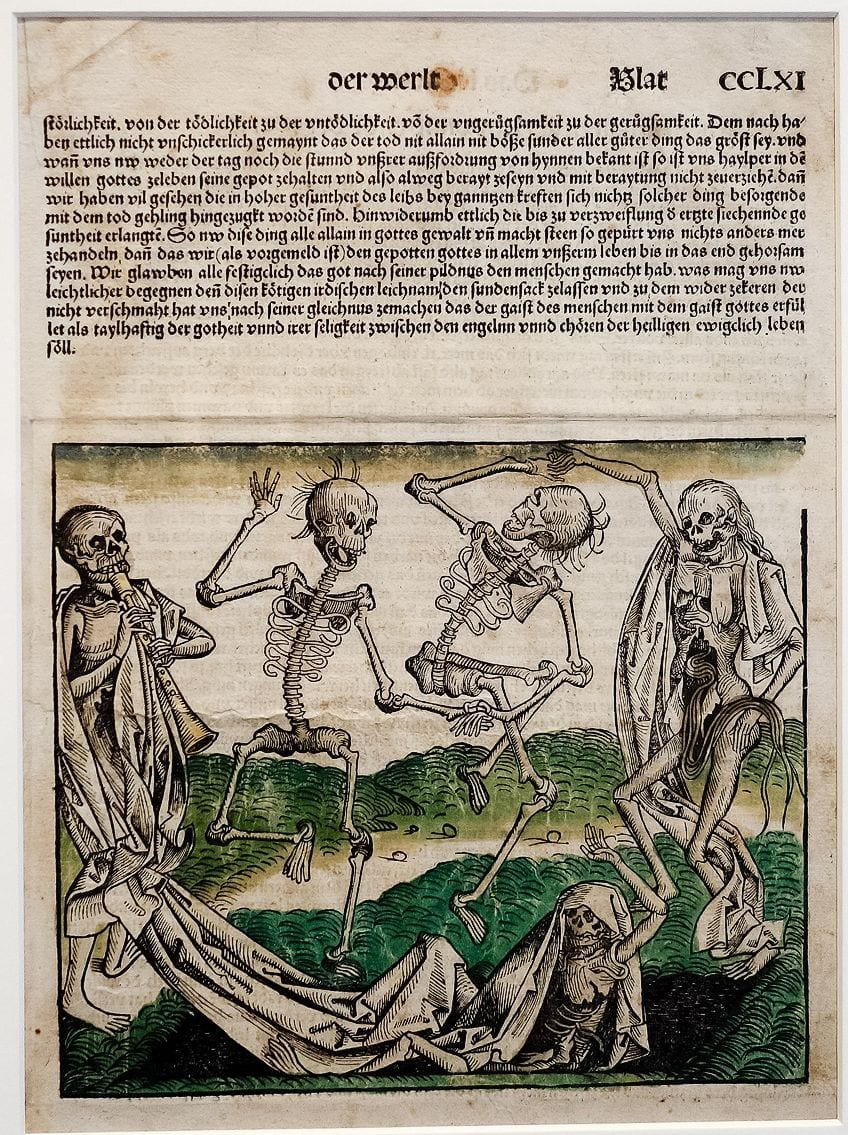
During those early years of the style’s development, death was a common theme in people’s lives as epidemics raged frequently through populations. Wolgemut’s version of this theme, also titled The Dance of Death, is an illustration taken from the 1493 edition of the Nuremberg Chronicle, which documented the contemporary times and lives of those living in Nuremberg. The picture depicts the dead rising from their graves and engaged in a wild dance. Three skeletons dance hand in hand on the right, while another plays the flute on the left. Another skeleton seems to be moved by the music as it rises out of the grave.
With fatal diseases being a constant threat to the population, the image of death was always in the back of people’s minds, and memento mori artists were able to reflect that grim fascination with death back to the public.
Vanitas Still Life (1625) by Pieter Claesz
Pieter Claesz was a Dutch Golden Age painter born in Berchem, Belgium in 1597. In 1621, at the age of 24, he became a professional artist and settled in Harlem. His specialization was painting Vanitas and breakfast still lifes. He was chiefly known for his monochrome still-life paintings from 1630 onwards, but before this period, his paintings still contained colorful themes, such as can be seen in his still-life from 1625, entitled Vanitas Still Life.
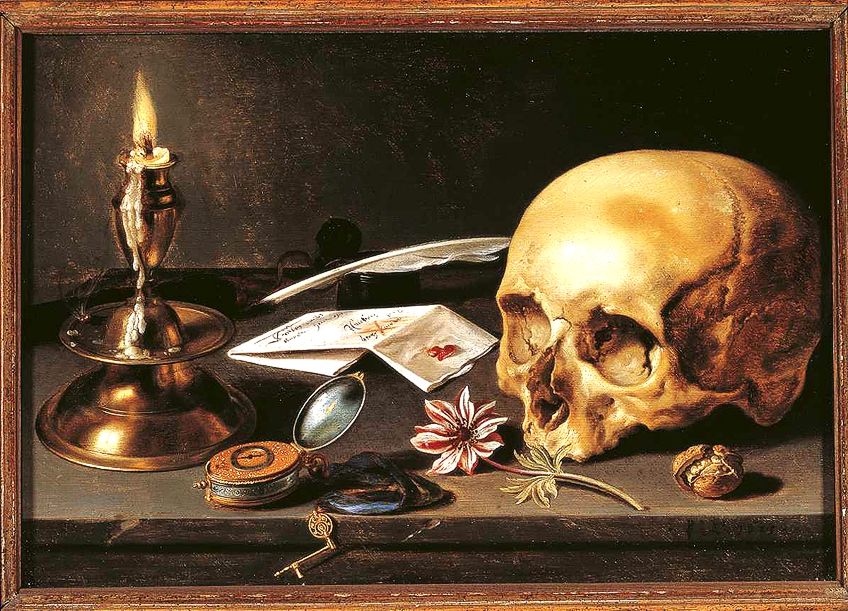
In this painting, there remain colorful elements from his older style, such as the blue of the silk ribbon or the anemone with its vivid red and white coloring. The anemone had been used because it exists for such a short time, one of several constant reminders in famous paintings of death of the temporary existence of life. Other symbolic reminders of death can be seen in the placement of a skull, a watch, and a melting candle throughout the composition.
Young Man with a Skull (1626) by Frans Hals
Frans Hels the Elder was born in Antwerp, Belgium in 1582. Living mostly in Harlem, he painted mostly portraits and was a Dutch Golden Age painter, renowned for his role in the development of portraiture in the 17th century. His portraits included paintings of high society citizens such as Isaac Massa and Pieter van den Broeke. He also created group paintings of health workers in the hospitals and for the local civic guard. Through his paintings, historians can catch a glimpse at the various levels of society that existed in Hals’ time, as he painted everyone from tavern heroes to mayors, fishwives to clerks.
His style became admired and replicated due to its radically free approach to realism. He was able to capture the essence of the character and moment in the expressions and poses of his subjects.
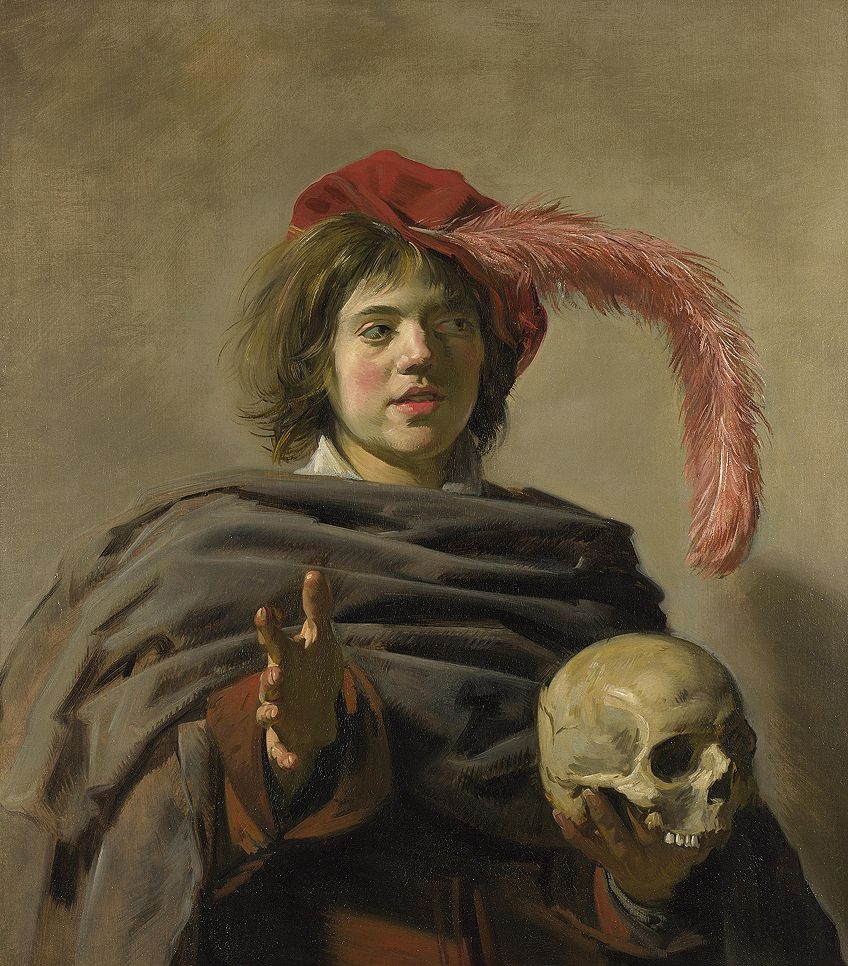
Hals painted Young man with a Skull in 1626, which was for a time thought to portray the skull of Yorick from Shakespeare’s Hamlet. It is now, however, thought to be a memento mori painting or Vanitas, a reminder of the fleeting and temporary nature of existence. The famous painting of death portrays a youngish man, robed in a cloak and wearing a red feathered bonnet on his head. In his left hand, he holds a skull, and with his right hand, he gestures towards the observer.
The idea that the painting portrayed Hamlet was put into question by the fact that many portraits from that period contained skulls and none were a reference to Shakespeare’s work. It was also highly improbable as Shakespeare’s work was not known in the Northern Netherlands in the 1620s.
Still Life, An Allegory of the Vanities of Human Life (1640) by Harmen Steenwijck
Harmen Steenwijck was a Dutch Golden Age painter born in Delft in the Netherlands in 1612. His father sent him and his brother to study under their uncle, David Bailly. It was Bailly who inspired Harmen to start painting art in the Vanitas style. He then became a consistently active artist from 1628 to 1633 in Leiden, after which he returned to Delft in 1633. He is most well-remembered for his painting An Allegory of the Vanities of Human Life, which he painted in 1640. It was essentially a religious sermon in the guise of a still life painting and is a prime example of the Dutch Vanitas painting style.
As with all Vanitas art, the skull still life composition was rich with memento mori symbols, depicting the earthly pitfalls that stand between man and salvation from damnation and the eternity of death.
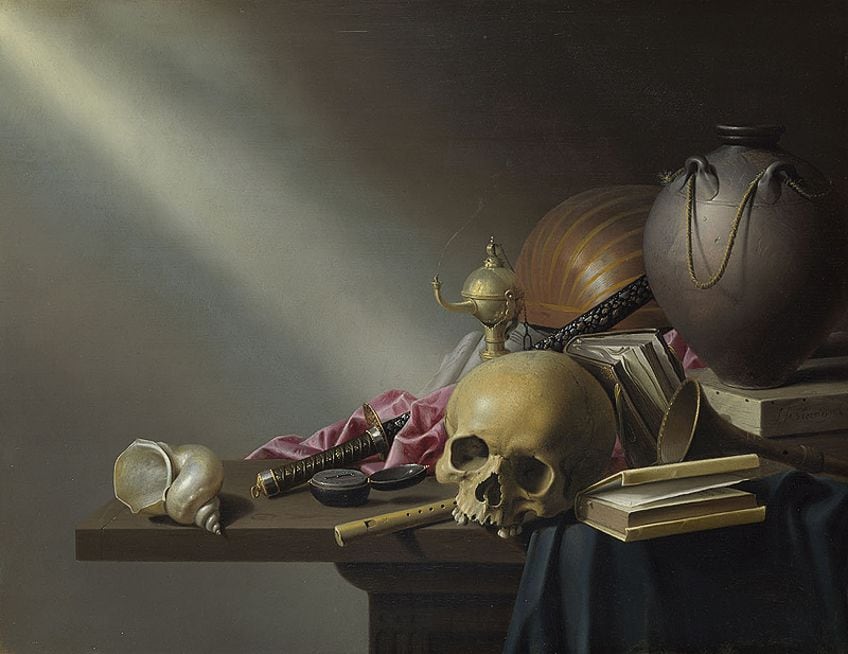
Therefore, the skull has been positioned as the focal point of the composition, the universal symbol of death. The oil lamp and pocket watch mark the passing of time, marching towards an inevitable outcome, as no lamp can burn forever. The specific shell used in this memento mori painting is a representation of wealth, as it came from a far-off land and was highly polished. Books and musical instruments can also be seen in the composition, representing knowledge as well as luxurious indulgences. Being the most expensive color dye, the purple silk cloth is a symbol of material wealth and luxury.
Self-Portrait With Vanitas Symbols (1651) by David Bailly
David Bailly was a Dutch Golden Age painter born in Leiden in the Dutch Republic in 1584. Bailly was a student of Jacques de Gheyn, a copper engraver, and his father Peter Bailly, a calligrapher. Afterward, he apprenticed with the Dutch portrait painter Cornelius van der Voort. In 1608, while working as a journeyman, he went on his Grand Tour, which was a tradition where upper-class men would travel around Europe. He traveled to Nuremberg, Augsburg, Frankfurt, and Hamburg, and then on to Venice and Rome, working for several princes during his return voyage. In 1613, upon his return to the Netherlands, he began painting portraits and still-life paintings.
He became known for his Vanitas-style paintings, which included memento mori symbols of impermanence such as half-burnt candles, wilting flowers, and skulls.
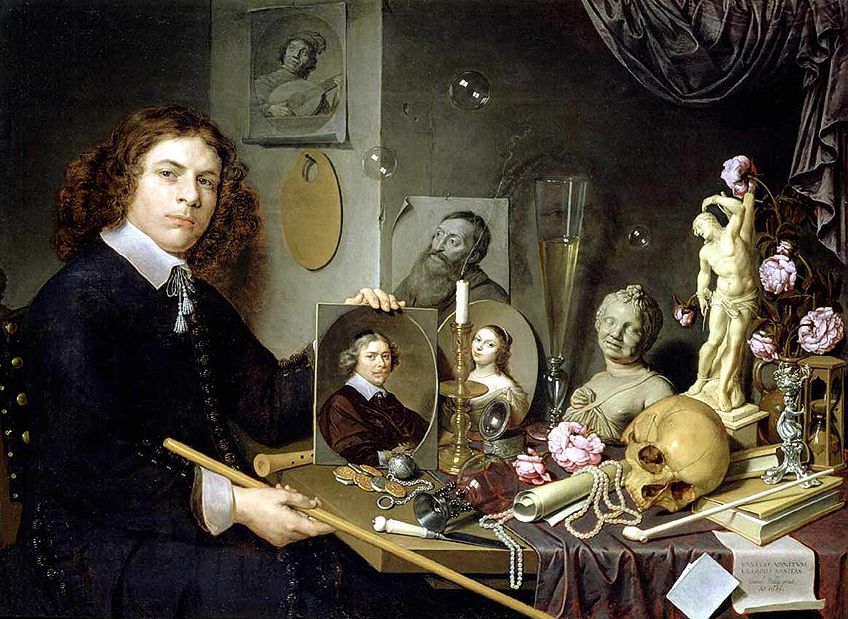
In Self-Portrait With Vanitas Symbols, the memento mori artist has blurred the lines between the two styles of portraiture and still-life painting. There are several portraits within the portrait, as well as coins, a skull, a timepiece, a rose, an extinguished candle, a sculpture, a pearl necklace, and other symbols of transience, such as the bubbles floating across the canvas.
Another feature that adds a new dimension to the artwork is the fact that the artist had painted himself several decades younger than he was at the time of creating the painting. However, his 67-year-old version can still be seen looking out at the viewer from one of the smaller portraits within the painting.
By changing the references of time, the painting suggests that the young artist awaits his future age in anticipation, a mixture of time frames that are meant to nudge the viewer into contemplating the nature of time and permanence.
Vanitas Still Life (1668) by Maria van Oosterwijck
Maria van Oosterwijck was born on the 20th of August, 1630 in Nootdorp, the Netherlands. At a young age, van Oosterwijck’s father took her to see a still-life painter, the masterful Jan Davidsz de Heem. His work greatly influenced her and she became his student, soon developing her talent as a painter of realistic floral artworks.
For a while, she worked with de Heem, and after he moved to Antwerp she began to focus on her independent paintings. Her work soon became renowned in Holland as well as in Germany, where patrons included Roman Emperor Leopold I, Louis XIV from France, William III from England, and the King of Poland. Despite all her success as a Memento Mori artist, she was never granted access to the painter’s guild, as women were not allowed to attain membership.
Maria van Oosterwijck’s artworks (such as her Vanitas skull still lifes) were deeply symbolic and allegorical, a style that was highly sought after in Europe during this era.
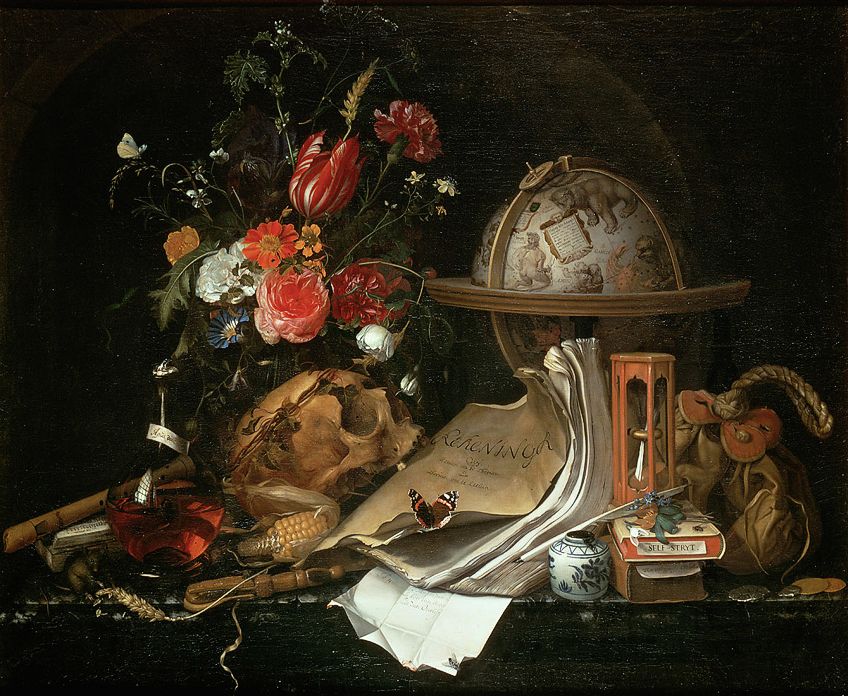
Her use of extremely dark backgrounds and vivid foreground colors led to her being regarded as one of the most eminent painters of the Netherlands and surrounding areas. Her use of light and shadow were used to great effect, employing the technique of chiaroscuro – the dramatic interplay between light and dark. By incorporating allegorical elements, her work reflects themes such as impermanence, the vanity of man, and the moral obligation to meditate on one’s devotion to the Divine. Her paintings make use of objects that impart a sense of the transient nature of time, such as wilting flowers, skulls, and hourglasses.
Unlike many of her contemporaries, her work offered some respite from the gloominess of death by incorporating objects that represented resurrection and rebirth.
Still-Life with a Skull (1671) by Philippe de Champaigne
Philippe de Champaigne was born in Brussels in 1602. He moved to Paris in 1621 and became a prominent figure of the Baroque era in France. He created a huge number of paintings, including portraits and religious works. Philippe de Champaigne was initially influenced by Rubens at the start of his art career, but later, his style became more grim and austere. His work is highly regarded thanks to its stern compositional strength and the vividness of his color palette. He painted portraits of royalty, governmental officials, and high nobility.
When portraying their faces, he sought to capture the characteristic essence of the person instead of transitional expressions.
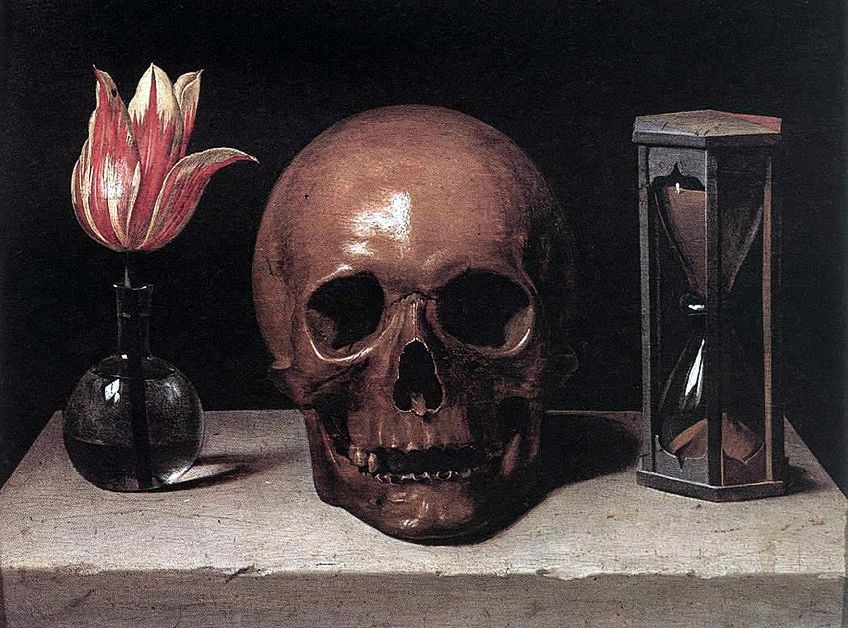
The skull painting Still-Life with a Skull by de Champaigne is termed a Vanitas – a picture that encouraged one to reflect on the temporary nature of life and the seemingly worthless pursuits therein. It portrays three traditional memento mori symbols of doom and impermanence.
A skull to symbolize the inevitability of death, a tulip to symbolize the briefness of glory, and an hourglass to symbolize the never-ending march of time that waits for no man.
The various objects are positioned evenly spaced on a large stone block. Central to the composition and staring directly at the viewer is a skull, reflecting one’s mortality at the observer. A tulip rests in a small bowl of water to the left. The flower was once a bud, which then bloomed forth for a brief second of magnificence before beginning to wilt away into nothing. The hourglass reminds one that time is limited for each of us, and the sand can be seen counting the passing of time with the drop of each grain.
Sceleti et Musculorum Corporis Humani (1749) by Bernhard Siegfried Albinus
Bernhard Siegfried Albinus was a German-born Dutch professor and anatomist. He was born on the 24th of February, 1697 in Frankfurt, Germany. After his father moved the family to the Netherlands to take up residence at Leiden University as the chair of medicine, Bernhard began his studies with Boerhaave, considered the father of physiology, at the age of 12. After years of studying anatomy in Paris under various tutors, he returned to Leiden to take up a position at the university as a lecturer of surgery and anatomy.
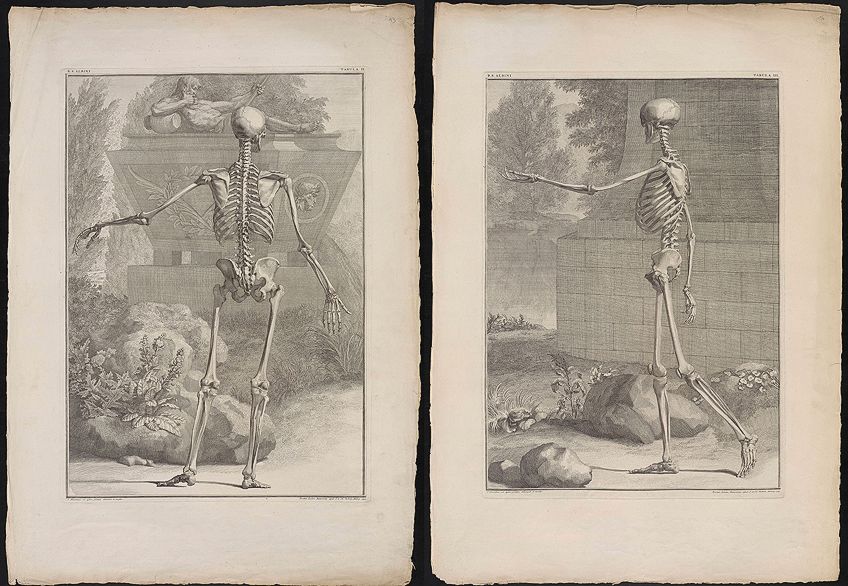
He is most well-remembered for his work with Jan Wandelaar, a tablature known as Sceleti et Musculorum Corporis Humani. Wandelaar was an engraver, and together with Albinus, they created pictures that were renowned for their artistic beauty as well as scientific accuracy. To ensure correct proportionality and accurate anatomic representation, they would overlay a mesh grid while sketching the drawings. Wandelaar would then add detailed backgrounds to create a sense of realism.
Bernhard Siegfried published the beautifully illustrated volume mostly at his own expense, and although many people criticized Wanderlaar’s whimsical treatment of the volume’s scientific subject matter, he was strongly defended by its co-creator.
Skull with Burning Cigarette (1885) by Vincent van Gogh
Vincent Willem van Gogh was born on the 30th March 1853 in Zundert in the Netherlands. He was a Dutch Post-Impressionist painter who only after his death was recognized as one of the most influential artists in the history of western art. He created more than 2,100 artworks in the last decade of his life, including 860 oil paintings, many of which were said to have been painted in the last two years of his life.
These include still-lifes, self-portraits, and landscape paintings characterized by their dramatic and bold colors and expressive brushstrokes, all of which influenced the art movement for many decades well into the present day.
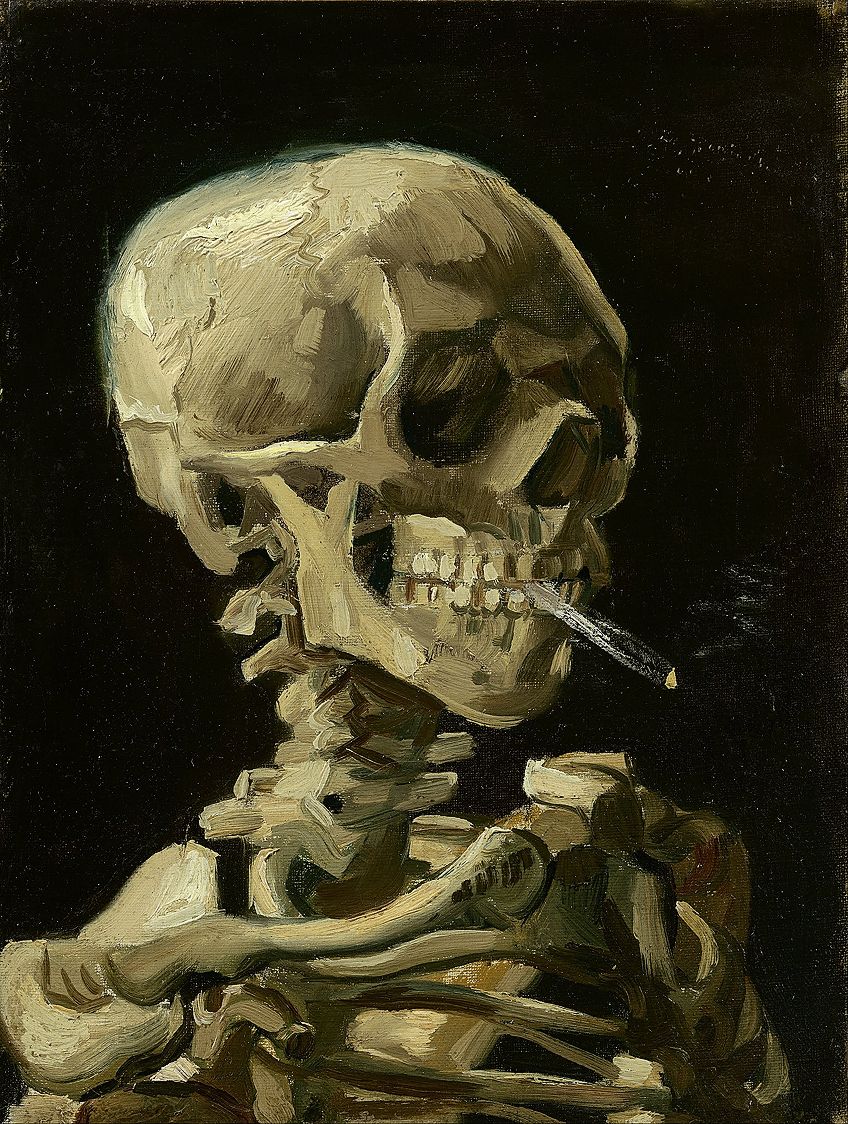
Skull with Burning Cigarette was painted with oil on canvas in 1885 and is now housed at the Van Gogh Museum (Vincent van Gogh Foundation.) Painted while van Gogh was studying art at the academy in Antwerp, Skull with Burning Cigarette was initially created as a juvenile joke. However, it still shows a decent understanding of anatomy and composition. It was a standard exercise to sketch skeletons at the academy, but it was not part of the curriculum to paint them, so it is assumed that van Gogh must have created this work after the day’s studies or perhaps during lessons solely for his enjoyment.
Pyramid of Skulls (c. 1901) by Paul Cézanne
Paul Cézanne was a French Post-Impressionist painter whose art helped mark the transition from 19th to 20th-century concepts and aesthetics. In the last decade of Paul Cézanne’s life, he worked in isolation and often hinted at his feelings towards his mortality in his letters to friends.
He is said to have had a slight fascination with death and mortality since the 1870s, but it would be more than another 20 years before he started to implement the concept of death in art form. Around the time he started adding memento mori symbolism into his art, his health began to rapidly decline. His ongoing preoccupation with the subject of death can be identified in a number of his skull paintings that he produced in 1898 and 1905.
Paul Cézanne’s paintings from this period were produced in watercolor as well as oils and offered a subtler version of the traditional Vanitas theme.
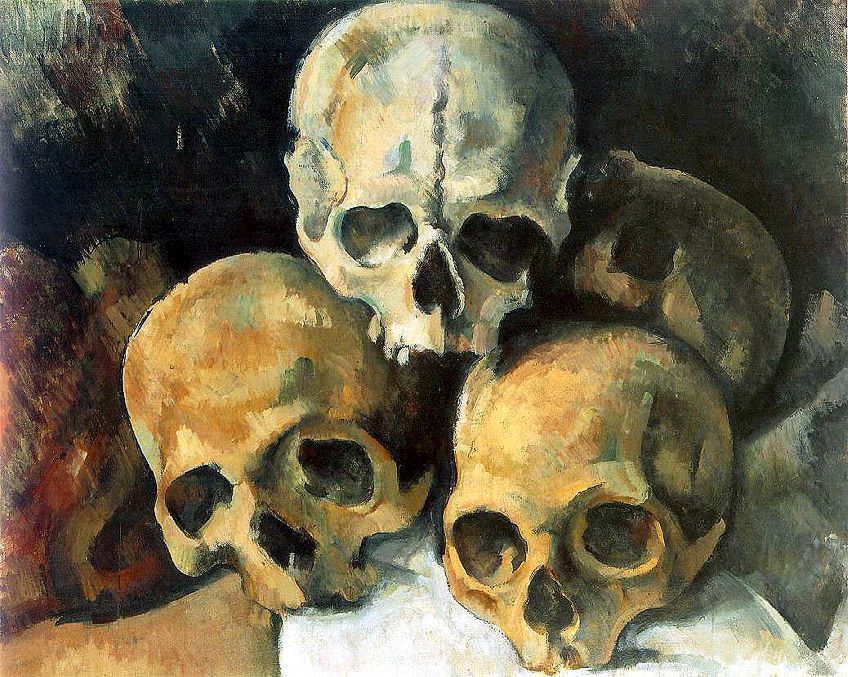
Painted in around 1901 with oil on canvas, Pyramid of Skulls is composed of three skulls portrayed under a pale light, lit against a dark background. It was perhaps not only his concerns over mortality that led to the use of skulls in his paintings. He was said to have appreciated the shape of the human skull and may have used them for the quality of their volumetric form as he did with vases and fruit. Reminiscent of his portraits, the skulls stare at the viewer in a confrontationally head-on pose. He could also have incorporated skulls as they were common objects in the houses of Catholics, Catholicism being a religion he was a devout follower of.
Today, we have learned about the intriguingly dark topic of memento mori. We have discussed how a philosophy on the inevitable nature of death has affected artists throughout the centuries to create works of art that reflect their contemplations on the impermanence of life, the fruitless pursuit of happiness in worldly things, and the abandonment of sin, all in return for the chance of salvation from the pitfalls of human existence.
Take a look at our art memento mori webstory here!
Frequently Asked Questions
Was Memento Mori an Art Movement?
Memento mori was more of a philosophy of thought than a movement of artists. Yet the symbolism of memento mori can be found in the art of many painters from a multitude of art styles. Death is a common theme for many artists and something that everyone will one day have to experience, so it makes sense that the concept of morality is a theme that surpasses genre or style and can be discovered almost everywhere in art.
What Does Vanitas Mean?
Vanitas paintings are a specific type of art representing death and the impermanence of life through still-life paintings. These still-life paintings are usually composed of objects that are highly charged with symbolism, specifically with regard to death. The most common objects painted by memento mori artists in Vanitas include skulls, timepieces such as clocks or hourglasses, wilting flowers, or rotting fruit. Many objects could be used to symbolically mark the passage of time and represent the temporary nature of life.
Isabella studied at the University of Cape Town in South Africa and graduated with a Bachelor of Arts majoring in English Literature & Language and Psychology. Throughout her undergraduate years, she took Art History as an additional subject and absolutely loved it. Building on from her art history knowledge that began in high school, art has always been a particular area of fascination for her. From learning about artworks previously unknown to her, or sharpening her existing understanding of specific works, the ability to continue learning within this interesting sphere excites her greatly.
Her focal points of interest in art history encompass profiling specific artists and art movements, as it is these areas where she is able to really dig deep into the rich narrative of the art world. Additionally, she particularly enjoys exploring the different artistic styles of the 20th century, as well as the important impact that female artists have had on the development of art history.
Learn more about Isabella Meyer and the Art in Context Team.
Cite this Article
Isabella, Meyer, “Memento Mori Art – Symbolic Meditations on Death.” Art in Context. August 24, 2021. URL: https://artincontext.org/memento-mori-art/
Meyer, I. (2021, 24 August). Memento Mori Art – Symbolic Meditations on Death. Art in Context. https://artincontext.org/memento-mori-art/
Meyer, Isabella. “Memento Mori Art – Symbolic Meditations on Death.” Art in Context, August 24, 2021. https://artincontext.org/memento-mori-art/.


